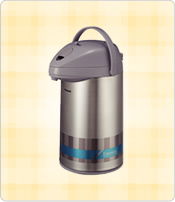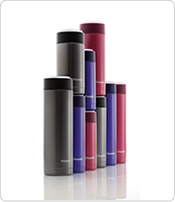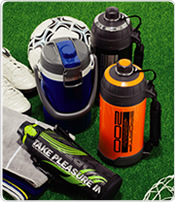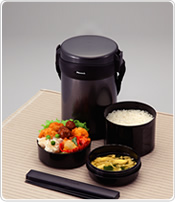


| ● |
Do not use this product for any purpose other than keeping beverages warm or cold. |
| ● |
Do not carry this product around in a tilted position or with the push lever pressed. (Handy Pot) |
| ● |
This product should not be filled with any of the following items: |
| 1. |
Dry ice or beverages containing carbon dioxide (The pressure inside the product will increase, causing the beverage to spout out and possibly causing injuries.) |
| 2. |
Soups and other beverages containing salt (Prolonged storage may spoil these beverages, and the salt will stick to the sides of the inner flask, causing rust.) |
| 3. |
Milk-based beverages or fruit beverages(Prolonged storage may spoil the beverages. This will increase the pressure inside the product, causing the beverage to spout out and possibly causing injuries.) |
| 4. |
Fruit pulp, or tea and other kinds of leaves (These may cause blockages and possible malfunctions.) |


| ● |
Outer container and Lid
Wipe with a soft cloth dampened with warm water and detergent and thoroughly wrung out. Then wipe off with a dry cloth and allow each part to dry thoroughly. |
| ● |
Inside the container:
Wash the inner container with a sponge dampened with water containing detergent. Pour hot water into the container and rinse. Allow it to dry thoroughly. |
| ● |
Pipe:(Air Pump Pot Only)
Put the pipe into the warm water containing detergent and wipe the pipe with a sponge and rinse. |
How to deal with reddish rust-like spots on the inner container:
The reddish rust-like spots are the result of mineral components (such as calcium, magnesium and iron) contained in water. To remove the spots, follow below steps.
| 1. |
Dilute some citric acid (approx. 10g) in warm water that can fill up the inner container and pour it into the product.
|
| 2. |
Let it soak for 2 to 3 hours. Then clean with a soft brush or sponge and rinse several times with water.
|
| 3. |
Allow the inner container to dry thoroughly.
|


Pipe (Air pump type) and gasket (Lid gasket/pipe gasket) are consumable parts. Please check once every 6 months to 1 year for damage or deterioration.



| ● |
Do not use this product for any purpose other than keeping beverages warm or cold.
|
| ● |
Make sure the gasket and spout are properly set to prevent water leakage and scald.
|
| ● |
Do not place the bottle on its side. (To avoid water leakage)
|
| ● |
Do not remove the protective sheet on the underside of the thermal casing.
|
| ● |
Do not place the bottle with computer, mobile and digital camera (To avoid water leakage and damage the gadgets.)
|
| ● |
Do not use the bottle while driving.
|
| ● |
Do not knock over, drop or expose the bottle to excessive shocks. The heat retention capability will be greatly affected if the bottle is damaged.
|
| ● |
Do not shake the bottle after filling the bottle with hot water.
|
| ● |
Do not put the body, gasket and spout of the bottle into the spoiling hot water , dish washer or dish dryer to prevent damage or transform.
|
| ● |
This product should not be filled with any of the following items:
|
| 1. |
Dry ice or beverages containing carbon dioxide (The pressure inside the product will increase, causing the beverage to spout out and possibly causing injuries.)
|
| 2. |
Soups and other beverages containing salt (Prolonged storage may spoil these beverages, and the salt will stick to the sides of the inner flask, causing rust.)
|
| 3. |
Milk-based beverages or fruit beverages(Prolonged storage may spoil the beverages. This will increase the pressure inside the product, causing the beverage to spout out and possibly causing injuries.)
|


Wash it with soft sponge and diluted dish soap or warm water. Rinse well with running water. Wipe off the moisture on the outer surface with dry cloth. Ensure all moisture is wiped from the product after cleaning.
How to deal with reddish rust-like spots on the inner container:
The reddish rust-like spots are the result of mineral components (such as calcium, magnesium and iron) contained in water. To remove the spots, follow below steps.
| 1. |
Dilute some citric acid (approx. 10g) in warm water that can fill up the inner container and pour it into the product.
|
| 2. |
Let it soak for 2 to 3 hours. Then clean with a soft brush or sponge and rinse several times with water.
|
| 3. |
Allow the inner container to dry thoroughly.
|

Gasket and spout cap gasket are consumable parts. Please check once every 6 months to 1 year for damage or deterioration.



| ● |
For cold beverages only.
|
| ● |
Do not add hot beverages into the bottle. (To avoid burns, injuries, or damage to the product)
|
| ● |
Do not immerse the container and lid in water.
|
| ● |
Be sure the spout cap and safety stopper is securely locked.(To avoid water leakage)
|
| ● |
Do not put the jug into the dish washer or the dish dryer.
|
| ● |
Do not knock over, drop, or expose the jug to excessive shocks.
|
| ● |
Do not place the jug on its side.
|
| ● |
This product should not be filled with any of the following items:
|
| 1. |
Dry ice or beverages containing carbon dioxide (The pressure inside the product will increase, causing the beverage to spout out and possibly causing injuries.)
|
| 2. |
Milk-based beverages or fruit beverages(Prolonged storage may spoil the beverages.)
|
| 3. |
Juice or tea and other kinds of leaves (These may cause blockages and possible malfunctions.)
|

Gasket and spout cap gasket are consumable parts. Please check once every 6 months to 1 year for damage or deterioration.



| ● |
Do not use the lunch jar for any purpose other than keeping food warm or cold.
|
| ● |
Do not immerse the thermal casing in water.
|
| ● |
Please follow below instructions when using a microwave oven for heating food:
|
| 1. |
Detach the lids from the inner containers before microwaving.
|
| 2. |
Do not heat the thermal casing in a microwave.
|
| 3. |
Do not heat the food in grill or oven mode of combination microwave ovens.
|
| 4. |
Do not heat empty container.
|
| 5. |
Do not heat oily or sugary foods for long period of time.
|
| 6. |
Do not lay the lunch jar on its side.
|
| 7. |
Consume all foods within 6 hours.
|
| 8. |
Do not put the chopsticks and the chopsticks case into the dishwasher or dish-dryer.
|


| ● |
Wash in warm water with a sponge and detergent, and then rinse.
|
| ● |
Wipe off water with a dry cloth and allow each piece to dry thoroughly.
|
| ● |
The thermal casing is made of 18-8 stainless steel.
|
| ● |
Cleaning rust-like spots on the inside of the thermal casing:
|
| 1. |
Dilute some citric acid (approx. 10g) in warm water tand pour into the thermal casing.
|
| 2. |
Let it soak for 2 to 3 hours. Then clean with a soft brush or sponge and rinse several times with water.
|
| 3. |
Wipe the inside of the containers with a dry soft cloth and allow the containers to dry thoroughly.
|
As a substitute: Use 1/2 cup of white vinegar instead of citric acid.

The gaskets for the soup containers are consumable parts. Please check once every 6 months to 1 year for damage or deterioration.

We know there’s a growing concern about the safety of plastic products. That’s why we would like to make it clear that all of our “Peacock” products are made with BPA free materials. BPA, or bisphenol A, is the chemical used to manufacture the lining of food and beverage cans and polycarbonate plastic products. All of the materials we use have been tested and conform to the Japanese Food Sanitation Act. So you can use them with complete confidence.
Major materials used for contact with water.
| ● |
Gasket: Silicone rubber
|
| ● |
Drinking cap : Food-grade Polypropylene
|
| ● |
Stainless steel bottle, tank : SUS316 18/10 high quality stainless steel
|
| ● |
Stainless steel bottle, tank : SUS304 18/8 high quality stainless steel
|


Besides our home market in Japan, we are now extending our Peacock brand products to many countries and have received great success. We continue to look for business partners that are willing and capable of selling and servicing Peacock products in new markets.
We strongly encourage you to contact our Export Department. All export enquiries are welcome. It will be our pleasure to grow with your business in your market! Please send us an e-mail and we will get back to you soon.
















